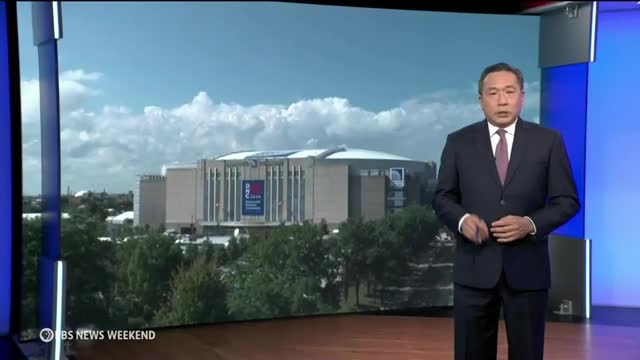Chicago's 1968 Convention Echoes in Today's Political Turmoil
This article was created by AI summarizing key points discussed. AI makes mistakes, so for full details and context, please refer to the video of the full meeting. Please report any errors so we can fix them. Report an error »

Chicago's legacy as the host of numerous presidential conventions is marked by its most tumultuous event in 1968, a year defined by deep societal divisions and protests against the Vietnam War. This historical moment is revisited in Judy Woodruff's ongoing series, \"America at a Crossroads,\" highlighting its relevance to contemporary political tensions.
The 1968 Democratic National Convention unfolded against a backdrop of national unrest, including the assassination of civil rights leader Martin Luther King Jr. and the ongoing Vietnam War, which had claimed thousands of American lives. As President Lyndon Johnson opted not to seek re-election, the Democratic Party faced internal strife, culminating in the nomination of Vice President Hubert Humphrey amid protests and violence.
Michael James, a participant in the protests, recalled the fervor of the time, noting that demonstrators were driven by a broader awareness of social issues, including civil rights and women's movements. The protests escalated dramatically when police clashed with demonstrators, leading to violent confrontations that were broadcasted live, capturing the nation's attention. The infamous phrase \"the whole world is watching\" echoed through the streets as police responded with force, further polarizing public opinion.
Historian Rick Perlstein emphasized the chaos both inside and outside the convention hall, where delegates debated the party's stance on the Vietnam War. The events of that summer marked a significant turning point in American politics, with many Americans siding with law enforcement, paving the way for Richard Nixon's campaign centered on restoring order.
Fast forward to today, the political landscape remains fraught with conflict, as a sitting Democratic president has stepped aside and tensions over issues like women's rights and racial equality resurface. The Republican candidate, facing legal challenges, similarly promises a return to law and order.
While the dynamics of political conventions have evolved since 1968, with reforms allowing greater voter participation in the nomination process, questions linger about the engagement of younger voters in the current political climate. Perlstein noted that while there is passionate activism surrounding contemporary issues, the stakes differ significantly from those faced by young Americans during the Vietnam War.
As the Democratic Party prepares for its upcoming convention, the atmosphere is markedly different from the chaos of 1968. With a clear candidate in Kamala Harris, the party appears unified, though the energy of the electorate may not reflect the same urgency as in the past. Both James and Perlstein expressed a desire to avoid the violence of the past, recognizing the potential consequences of political upheaval in today's context.
In summary, the 1968 Democratic National Convention serves as a historical lens through which to view current political tensions, illustrating how past events continue to shape the American political landscape.
The 1968 Democratic National Convention unfolded against a backdrop of national unrest, including the assassination of civil rights leader Martin Luther King Jr. and the ongoing Vietnam War, which had claimed thousands of American lives. As President Lyndon Johnson opted not to seek re-election, the Democratic Party faced internal strife, culminating in the nomination of Vice President Hubert Humphrey amid protests and violence.
Michael James, a participant in the protests, recalled the fervor of the time, noting that demonstrators were driven by a broader awareness of social issues, including civil rights and women's movements. The protests escalated dramatically when police clashed with demonstrators, leading to violent confrontations that were broadcasted live, capturing the nation's attention. The infamous phrase \"the whole world is watching\" echoed through the streets as police responded with force, further polarizing public opinion.
Historian Rick Perlstein emphasized the chaos both inside and outside the convention hall, where delegates debated the party's stance on the Vietnam War. The events of that summer marked a significant turning point in American politics, with many Americans siding with law enforcement, paving the way for Richard Nixon's campaign centered on restoring order.
Fast forward to today, the political landscape remains fraught with conflict, as a sitting Democratic president has stepped aside and tensions over issues like women's rights and racial equality resurface. The Republican candidate, facing legal challenges, similarly promises a return to law and order.
While the dynamics of political conventions have evolved since 1968, with reforms allowing greater voter participation in the nomination process, questions linger about the engagement of younger voters in the current political climate. Perlstein noted that while there is passionate activism surrounding contemporary issues, the stakes differ significantly from those faced by young Americans during the Vietnam War.
As the Democratic Party prepares for its upcoming convention, the atmosphere is markedly different from the chaos of 1968. With a clear candidate in Kamala Harris, the party appears unified, though the energy of the electorate may not reflect the same urgency as in the past. Both James and Perlstein expressed a desire to avoid the violence of the past, recognizing the potential consequences of political upheaval in today's context.
In summary, the 1968 Democratic National Convention serves as a historical lens through which to view current political tensions, illustrating how past events continue to shape the American political landscape.
View full meeting
This article is based on a recent meeting—watch the full video and explore the complete transcript for deeper insights into the discussion.
View full meeting